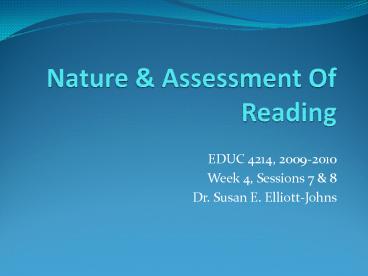Nature - PowerPoint PPT Presentation
1 / 17
Title:
Nature
Description:
a) How might home and school experiences have shaped' your views? ... Development of a coherent view of reading will evolve over time as you work in ... – PowerPoint PPT presentation
Number of Views:178
Avg rating:3.0/5.0
Title: Nature
1
Nature Assessment Of Reading
- EDUC 4214, 2009-2010
- Week 4, Sessions 7 8
- Dr. Susan E. Elliott-Johns
2
The Wuggen the Tor (S. Rich, 2001)
- Once upon a pyme, the Wuggen grolled an grolled
until ze motted a Tor. - Ze glind to the Tor, Ik am blongby and grolling
for poft. Do you noff mehre ik can gine some
poft? - Kex, glind the Tor, klum with me Wuggen. Ik
have lodz of poft in ni bove.
3
The Wuggen and the Tor.(Class Activity A
Individual/Whole Class)
- 1. What did the Wuggen do?
- 2. What was the Wuggen grolling for?
- 3. Who did the Wuggen mot?
- 4. Did the Tor have any poft?
- 5. Where was the poft?
- 6. Whats a Wuggen?
- 7. What would you do if you were the Wuggen? Why?
- 8. Would you bring a Wuggen or a Tor home?
4
The Wuggen and the Tor.(Class Activity B Small
Group Discussion)
- a) Why were you able to read this passage and
answer some of the follow-up questions? - b) In what ways does this exercise remind you of
reading instruction you experienced as a student?
(Describe these experiences and relate them to
this exercise). - c) What does this exercise demonstrate about the
nature of reading? (e.g., Are you conceptualizing
or re-conceptualizing reading any differently
based on this experience?) - d) What are the implications of this exercise in
terms of reading instruction and assessment? What
does it suggest?
5
Understanding what we mean by Reading
- Examine YOUR current perspective on reading
- Refer to Page 117 Course Text Complete the
survey, Box 4.1 - Review P. 118, Fig. 4.1 Theoretical
Perspectives on Reading
6
Exploring four influential Perspectives on Reading
- Working in 8 Groups of 5 Participants in each,
explore the following Perspectives on Reading, as
assigned - Bottom-Up Perspectives (p. 118-119)
- Top-Down Perspectives (p. 119-120)
- Interactive Perspectives (p.120)
- Social Constructive Perspectives (p.121-122)
7
Your View of Reading(re. Exploring Perspectives)
- Revisit your own views. See P.123-124 Your View
of Reading interpret your responsestalk about
your views with a partner (Th., Pr., Sh.) - Discuss in Table Groups
- a) How might home and school experiences have
shaped your views? - b) Where do you see yourself in the process of
developing a coherent view of reading?
8
Consider
- reading goes well beyond decoding and when
conceptualizations of reading are decoding
focused, assessments do not always capture
students ability to actually make meaning
from/of a text.
9
The Nature of Reading a review
- Differing views presented (theoretical
orientations). - Clearly identifying your own perspective will
be an ongoing process . - Development of a coherent view of reading will
evolve over time as you work in classrooms, and
you further refine this view on the basis of your
experience and reading of the professional
literature. - What is important at this point isthat you have
thought deeply about what you believeand what
you will be assessing when you assess reading
(p.124). - Session 8
10
Whole to Part, Part to Whole Introducing The
Hour Glass Model (Iannicci, 2008)
- 1. Focus on Meaning (Whole)
- 2. Focus on Language (Part)
- 3. Focus on Use (Whole)
- Refer to the Handout distributed in class for
more details. - How does this model relate to the NU Direct
Instruction Lesson Plan?
11
From interactive perspectives
- Reading is seen as a cognitive process.
- Meaning results from interaction between the
reader and the text. - Processing proceeds from whole to part and part
to whole. - W P and P W (as Hour Glass Model)
- Interactive perspectives in many ways inform
balanced views of - literacy..
- (p. 120, Course Text).
12
Theory in Practice
- Example Annes Heart Maps.
- Re-read the Narrative by teacher Anne Gordon in
our Course Text - pp. 54-55 (Ch. 2).
13
Annes Heart Maps(Revisit the Narrative in
Course text p. 54-55, Ch. 2)
- In pairs, analyze discuss the narrative in
relation to the The Hour Glass Model. - How does Annes practice illustrate the whole to
part, part to whole framework? - What practices and events indicate an initial
focus on the whole? - What practices and events indicate a focus on a
part or parts? - What practices and events indicate a focus on
transfer (moving back to the whole)?
14
Connecting Theory to Practice
- With colleagues at your table, share any
examples where you think the Whole to Part, Part
to Whole framework was in use in a J/I language
lesson you have either observed or taught. - Re-visit the Framework to guide your thinking.
15
- According to Freire, one needs to be able to
read the word and the world - (Freire Macedo, 1987
- in Bainbridge, Heydon Malicky, 2009, p. 123)
16
DVD Presentation after the break
- Title of DVD Reading the World Content
Comprehension with Linguistically Diverse
Learners - Today you will view, take guided notes, and
discuss the excerpt on Content Comprehension
Across the Day and Throughout the Year (Disc 1) - KEY IDEAS
- Connecting content areas and literacy/language
arts - Research Literacy Content Comprehension
- Collaboration Colleagues (who?)working together
- Explicit teaching of a repertoire of
comprehension strategies for understanding
science social studies content
17
After the Presentation
- Identify 2 or 3 particularly interesting
examples/ideas from your Notes that youd like to
try incorporating into your own design of spaces
for J/I content comprehension and language
learning, in contemporary classrooms. - Share and discuss your examples/ideas at your
table group.































